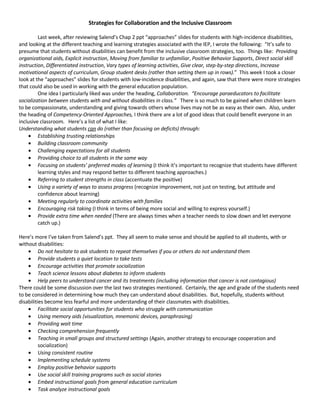
Strategies for Collaboration and the Inclusive Classroom
- 1. Strategies for Collaboration and the Inclusive Classroom Last week, after reviewing Salend’s Chap 2 ppt “approaches” slides for students with high-incidence disabilities, and looking at the different teaching and learning strategies associated with the IEP, I wrote the following: “It’s safe to presume that students without disabilities can benefit from the inclusive classroom strategies, too. Things like: Providing organizational aids, Explicit instruction, Moving from familiar to unfamiliar, Positive Behavior Supports, Direct social skill instruction, Differentiated instruction, Vary types of learning activities, Give clear, step-by-step directions, Increase motivational aspects of curriculum, Group student desks (rather than setting them up in rows).” This week I took a closer look at the “approaches” slides for students with low-incidence disabilities, and again, saw that there were more strategies that could also be used in working with the general education population. One idea I particularly liked was under the heading, Collaboration. “Encourage paraeducators to facilitate socialization between students with and without disabilities in class.” There is so much to be gained when children learn to be compassionate, understanding and giving towards others whose lives may not be as easy as their own. Also, under the heading of Competency-Oriented Approaches, I think there are a lot of good ideas that could benefit everyone in an inclusive classroom. Here’s a list of what I like: Understanding what students can do (rather than focusing on deficits) through: • Establishing trusting relationships • Building classroom community • Challenging expectations for all students • Providing choice to all students in the same way • Focusing on students’ preferred modes of learning (I think it’s important to recognize that students have different learning styles and may respond better to different teaching approaches.) • Referring to student strengths in class (accentuate the positive) • Using a variety of ways to assess progress (recognize improvement, not just on testing, but attitude and confidence about learning) • Meeting regularly to coordinate activities with families • Encouraging risk taking (I think in terms of being more social and willing to express yourself.) • Provide extra time when needed (There are always times when a teacher needs to slow down and let everyone catch up.) Here’s more I’ve taken from Salend’s ppt. They all seem to make sense and should be applied to all students, with or without disabilities: • Do not hesitate to ask students to repeat themselves if you or others do not understand them • Provide students a quiet location to take tests • Encourage activities that promote socialization • Teach science lessons about diabetes to inform students • Help peers to understand cancer and its treatments (including information that cancer is not contagious) There could be some discussion over the last two strategies mentioned. Certainly, the age and grade of the students need to be considered in determining how much they can understand about disabilities. But, hopefully, students without disabilities become less fearful and more understanding of their classmates with disabilities. • Facilitate social opportunities for students who struggle with communication • Using memory aids (visualization, mnemonic devices, paraphrasing) • Providing wait time • Checking comprehension frequently • Teaching in small groups and structured settings (Again, another strategy to encourage cooperation and socialization) • Using consistent routine • Implementing schedule systems • Employ positive behavior supports • Use social skill training programs such as social stories • Embed instructional goals from general education curriculum • Task analyze instructional goals
- 2. • Use positive behavior supports The final strategies are, again, are related to recognizing that students have different learning styles and may respond better to different teaching approaches. • Oral/Aural (use of speaking, speech, residual hearing) • Manual (use of visual-gestured language, e.g., sign language) • Bilingual-bicultural (use of visual-gestured language and written language) • Total communication (use of combination of approaches) • Tactile/kinesthetic activities